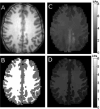Including spatial information in nonlinear inversion MR elastography using soft prior regularization
- PMID: 23797239
- PMCID: PMC4107367
- DOI: 10.1109/TMI.2013.2268978
Including spatial information in nonlinear inversion MR elastography using soft prior regularization
Abstract
Tissue displacements required for mechanical property reconstruction in magnetic resonance elastography (MRE) are acquired in a magnetic resonance imaging (MRI) scanner, therefore, anatomical information is available from other imaging sequences. Despite its availability, few attempts to incorporate prior spatial information in the MRE reconstruction process have been reported. This paper implements and evaluates soft prior regularization (SPR), through which homogeneity in predefined spatial regions is enforced by a penalty term in a nonlinear inversion strategy. Phantom experiments and simulations show that when predefined regions are spatially accurate, recovered property values are stable for SPR weighting factors spanning several orders of magnitude, whereas inaccurate segmentation results in bias in the reconstructed properties that can be mitigated through proper choice of regularization weighting. The method was evaluated in vivo by estimating viscoelastic mechanical properties of frontal lobe gray and white matter for five repeated scans of a healthy volunteer. Segmentations of each tissue type were generated using automated software, and statistically significant differences between frontal lobe gray and white matter were found for both the storage modulus and loss modulus . Provided homogeneous property assumptions are reasonable, SPR produces accurate quantitative property estimates for tissue structures which are finer than the resolution currently achievable with fully distributed MRE.
Figures











Similar articles
-
High-resolution mechanical imaging of the human brain by three-dimensional multifrequency magnetic resonance elastography at 7T.Neuroimage. 2014 Apr 15;90:308-14. doi: 10.1016/j.neuroimage.2013.12.032. Epub 2013 Dec 22. Neuroimage. 2014. PMID: 24368262
-
Magnetic resonance elastography of the brain using multishot spiral readouts with self-navigated motion correction.Magn Reson Med. 2013 Aug;70(2):404-12. doi: 10.1002/mrm.24473. Epub 2012 Sep 21. Magn Reson Med. 2013. PMID: 23001771 Free PMC article.
-
Viscoelasticity of subcortical gray matter structures.Hum Brain Mapp. 2016 Dec;37(12):4221-4233. doi: 10.1002/hbm.23314. Epub 2016 Jul 12. Hum Brain Mapp. 2016. PMID: 27401228 Free PMC article.
-
Suitability of poroelastic and viscoelastic mechanical models for high and low frequency MR elastography.Med Phys. 2015 Feb;42(2):947-57. doi: 10.1118/1.4905048. Med Phys. 2015. PMID: 25652507 Free PMC article.
-
[Magnetic resonance elastography 2.0: high resolution imaging of soft tissue elasticity, viscosity and pressure].Dtsch Med Wochenschr. 2013 Nov;138(47):2426-30. doi: 10.1055/s-0033-1343318. Epub 2013 Jul 9. Dtsch Med Wochenschr. 2013. PMID: 23839480 Review. German.
Cited by
-
Magnetic Resonance Elastography of Human Hippocampal Subfields: CA3-Dentate Gyrus Viscoelasticity Predicts Relational Memory Accuracy.J Cogn Neurosci. 2020 Sep;32(9):1704-1713. doi: 10.1162/jocn_a_01574. Epub 2020 May 7. J Cogn Neurosci. 2020. PMID: 32379003 Free PMC article.
-
Harnessing brain waves: a review of brain magnetic resonance elastography for clinicians and scientists entering the field.Br J Radiol. 2021 Mar 1;94(1119):20200265. doi: 10.1259/bjr.20200265. Br J Radiol. 2021. PMID: 33605783 Free PMC article. Review.
-
Stiffness reconstruction methods for MR elastography.NMR Biomed. 2018 Oct;31(10):e3935. doi: 10.1002/nbm.3935. Epub 2018 May 18. NMR Biomed. 2018. PMID: 29774974 Free PMC article. Review.
-
Mechanical properties of the in vivo adolescent human brain.Dev Cogn Neurosci. 2018 Nov;34:27-33. doi: 10.1016/j.dcn.2018.06.001. Epub 2018 Jun 10. Dev Cogn Neurosci. 2018. PMID: 29906788 Free PMC article.
-
Hippocampal viscoelasticity and episodic memory performance in healthy older adults examined with magnetic resonance elastography.Brain Imaging Behav. 2020 Feb;14(1):175-185. doi: 10.1007/s11682-018-9988-8. Brain Imaging Behav. 2020. PMID: 30382528 Free PMC article.
References
-
- Muthupillai R, Lomas DJ, Rossman PJ, Greenleaf JF, Manduca A, Ehman RL. Magnetic resonance elastography by direct visualization of propagating acoustic strain waves. Science. 1995 Sep.269:1854–1857. - PubMed
-
- Huwart L, et al. Magnetic resonance elastography for the noninvasive staging of liver fibrosis. Gastroenterology. 2008;135(1):32–40. - PubMed
-
- Ehman RL. Science to practice: Can MR elastography be used to detect early steatohepatitis in fatty liver disease. Radiology. 2009;253(1):1. - PubMed
-
- Asbach P, Klatt D, Hamhaber U, Braun J, Somasundaram R, Hamm B, Sack I. Assessment of liver viscoelasticity using multifrequency MR elastography. Magn. Reson. Med. 2008;60(2):373–379. - PubMed
Publication types
MeSH terms
Grants and funding
LinkOut - more resources
Full Text Sources
Other Literature Sources

